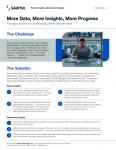Datatrak white paper analyses eClinical solutions
has concluded that larger investments and access to multicomponent,
single-source contracting options will create more efficient models
for businesses.
The paper, published by Datatrak specifically concentrates on eClinical solutions for the clinical trials industry, which discusses the advances in technology that the industry is set to benefit from.
"Experience-based estimations of market penetration for electronic clinical trials approximated 20 per cent at the end of 2005 and many pharmaceutical and biotechnology companies state expectations of performing more than 75 per cent of their clinical trials using electronic data collection (EDC) within the next five years," the report said.
The report focuses on a number of factors that are propelling the adoption of this technology. They are:
1. Advancement and improvement in available EDC technology suites and demonstrated scalability of large deployments.
2. Process efficiencies, including an ability to accelerate clinical development with improved quality over paper-based methods.
3. Regulatory encouragement from the FDA pertaining to the expected increasing reliance on electronic mediums for submissions to the Agency.
4. Significant cost savings compared to paper methods, proven by technology providers and clinical trial sponsors. This data refuted earlier biases that technology implementations were categorically more expensive than manually processing paper.
The report focuses particularly on the advantages eClinical solutions possess over paper-based business approaches.
"This business maturation will be different than what has occurred in paper-based models over the past few decades, because technology can be leveraged across larger deployments from initial investments while its predecessor, paper; cannot be scaled without directly commensurate increases in cost," the report commented.
The eClinical business model of the future needs to adopt a unique approach in order to do better than its predecessors. The report highlighted the fact that it needed to be appreciated that just like the clients it serves, technology providers in the market were also product development companies.
What is often overlooked is that product development companies owned patents and technologies that were proprietary and they did not process a medium such as paper that is ever-present.
Product development companies are always looking to the future in order to gain an advantage over competitors. Currently, it is the norm to invest a certain amount of annual revenue in products that will build for the future
"Pharmaceutical, biotechnology and medical device customers should identify with this situation very well, as they also live it every day. If prices for approved drugs or devices are not supported in such a manner as to foster proper development, innovation dies. When innovation and pipelines die, eventually, companies die," the report said.
Under the product development business model, the selling price is not simply a mathematical calculation of the number of service hours provided by hourly personnel using a ubiquitous medium with no proprietary value that required comparatively minimal investment to produce.
The report explained that often, selling prices for these products do not come from a cost-plus orientation. Tablets and capsules of drugs are priced at multiples more than the manufacturing cost that it takes to spin them off the production line.
Prices that are properly supported include the value being delivered and also account for appropriate and expected R&D investment in the future. The successful ones that made it to market support the investments on the ones that failed.
"Application of this concept towards eClinical applications is not fully appreciated by purchasing offices of either customers or technology providers but it probably should be, as evidenced by the wasted time and productivity resulting from the Enterprise Business Models previously mentioned unsuccessful business cases where both sides thought that the deal being struck portended success for the long-term," the report commented.
The report is available to read website. target="_blank">here.










